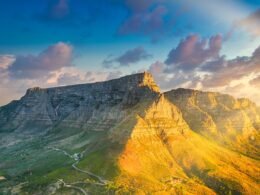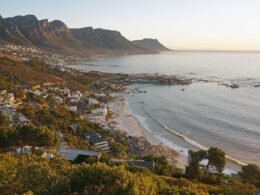Johannesburg is much more than just a pitstop – It’s a city that is well worth a visit. Despite its tumultuous history, you will find that nowadays Johannesburg is a vibrant metropolis that is bursting at the seams with culture.
There are so many things to do and experience so let’s get down to business and discuss the best way to spend 72 hours in South Africa’s biggest city.

Day 1:
Constitution Hill
Known by the locals as “Jo’burg” or Jozi” this cosmopolitan city is brimming with history, culture, and art. The history of Johannesburg is illustrated in its many museums. One of those historical museums is Constitution Hill – your first stop.
Constitution Hill was originally built as a military fort, then it was converted into a prison and finally transformed into the historical museum that it is today.
The museum offers a glimpse into the city’s unique past and visitors can walk the very same halls that Nelson Mandela once roamed.

Sadly, Mandela was not the only famous freedom fighter to be held at Consitution Hill when it was a prison – Gandhi was also an unwilling resident for a short time.
Constitution Hill remains a reminder of the tragic events that took place before South Africa found its way to democracy. Times have changed, but I can tell you firsthand that standing where these iconic heroes were once imprisoned is a somber feeling.
Hop on-hop off bus tour:
After your time at Consitution Hill, jump on a bus tour and explore some further sights:
You have no doubt seen these red buses in other cities of the world. They are a fun and convenient way to go sightseeing, and Johannesburg is no exception.
It’s safe, takes you to the city’s top sights, and it’s much cheaper than taking Uber. Below is more information:
Green Tour: Rosebank, Zoo Lake, Johannesburg Zoo, Military Museum, and Constitution Hill.
Red City Tour: Constitution Hill, Mining District, Carlton Center, James Hall Transport Museum, Gold Reef City Casino Hotel, The Apartheid Museum, and The Grove, Braamfontein.
Maboneng Precinct
After your bus tour, why not relax at The Maboneng Precinct? The precinct is yet another area of Johannesburg that has drastically changed over the years. For a long time, the Maboneng Precinct was an extremely dangerous area. It was known for being a hot spot for crime and most people stayed far away from it, but don’t fret, today it is completely transformed.
In fact, it is now a top destination for diners, shoppers, and art lovers. It’s the perfect place to have a nice lunch after Consitution Hill. You can unwind with a glass of wine and observe the bustling streets before calling it a day.
Day 2
Visit Soweto
Get an early start on your second day and head to Soweto. Once you get there, rent a bicycle and ride around the streets of South Africa’s most famous township.

Soweto is an urban settlement or “township” that was originally set aside for black South Africans. The birth of Soweto was rooted in racism, but the rapid growth can be attributed to the discovery of gold mines in this area.
With this discovery, foreigners and South Africans alike migrated to the area in search of labor and riches. I mean, who doesn’t want to go on a treasure hunt?
Soweto is most notably known as the birthplace of Nelson Mandela. You can visit his childhood home on the famous Vilkazi Street. While standing in the bedroom he grew up in, it’s impossible not to feel inspired when you see the humble beginnings of such a prolific political figure.

Riding through Soweto is an experience in and of itself. Soweto’s recognizable Orlando Towers is another landmark you can’t miss.
If you are more of an adrenalin junky than a history buff – you can climb to the top of the graffiti-covered towers and go bungee jumping. I bet that’s something you weren’t planning on checking off the bucket list.

Soweto is bursting at the seams with culture. There are bands playing traditional music, locals selling artisanal goods, and restaurants serving local foods.
You can feel the pride radiating from the people of Soweto. After all, they are from the same city as Nelson Mandela, Archbishop Desmond Tutu, and Trevor Noah ( the host of the Daily Show).
The Apartheid Museum
The apartheid museum is considered one of the principal attractions of Johannesburg. The museum holds memories of the harsh racial segregation laws that once plagued South Africa.
Apartheid is a heavy concept to understand, but it played an integral part in shaping the country.
The museum is open from Wednesday to Sunday from 9:00 am to 5:00 pm and it has an entrance fee of R150.00 ($9.00)

Afternoon activity:
After visiting Soweto and the Apartheid Museum, there are a couple of things you could do in the afternoon. You really can’t go wrong with whatever you decide to do:
Visit the Maropeng Cradle of Humankind & Sterkfontein Caves. As previously mentioned, Johannesburg was the birthplace of mankind. The bones of Hominids – the ancestors of modern humans – were found that date back to about seven million years ago. In addition, there are also caves to explore. Both exhibitions are open from 9 am to 4 pm, and the cost is R100 ($6) each.
Your third and final option is to just soak in more of the city. You can just tool around Oriental Plaza and enjoy all the delicious food, drinks, and shopping that Johannesburg has to offer.
Day 3:
Visit a national park:

Take an all-day trip to Pilanesburg National Park where you can experience the real African bush. If you’re lucky, you might spot a lion or two! This is a great option for you if your South African trip does not include a safari in Kruger National Park.
Interesting Facts About Johannesburg:
- It is the largest man-made urban forest in the world. There are trees, trees, and more trees scattered among skyscrapers.
- Bones of human ancestors were found there, and it is home to 40% of the earth’s human fossils.
- There was gold discovered in Johannesburg in the 1880s that triggered a gold rush, so it is quite literally a city of gold – but luckily this one isn’t lost!
Those are just a few of the interesting things about Johannesburg!
To Sum Up
While visiting Johannesburg you will no doubt be captivated by its beauty and moved by the joyful and heart-wrenching histories alike.














